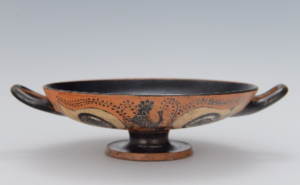FOR IMMEDIATE RELEASE
Ancient Greek Vases on View at Nelson-Atkins Museum of Art
Kansas City, MO. May 24, 2022– A new installation featuring nearly 40 ancient Greek vases from the collection of Omaha’s Joslyn Art Museum will be on view in The Nelson-Atkins Museum of Art’s Rozzelle court balcony in Kansas City beginning this June. The ancient Greeks built their perception of the world on their views of the gods and mythology. Thus, to the people who owned and used these objects, the stories depicted on these vases had relevance in everyday life.
Vase decoration provides us a view into their lives and values, but these scenes are not to be taken at face value. 
“The occurrence and frequency of scenes that blur the boundaries between myth and life offered the Greeks an opportunity to test the boundaries between men and women, human ‘reality’ and the not-quite-human world of myth,” said Julián Zugazagoitia, Menefee D. and Mary Louise Blackwell CEO & Director of the Nelson-Atkins.
An example of this was the prevalence of imagery featuring Dionysos, god of wine and fertility. Wine was a central part of Greek life. Celebrated during cultural festivities, wine-induced ritualistic dances, and depictions of drunken revelry, the worship of Dionysos provided a means for people to indulge in behavior normally forbidden. The Joslyn vase that is part of the exhibition was created around 500 BCE and issued a “warning” to the polis, or community structure of ancient Greece, to guard the balance between the wild self and the civilized self.
The ancient Greek vases on display range from 850 to 300 B.C.E.
“It was a time when borders of the empire were shifting, with influence extending all the way from Egypt and the Near East to modern-day Italy,” said Aimee Marcereau DeGalan, Louis L. and Adelaide C. Ward Senior Curator of European Arts. “Arranged by themes still recognizable to us today including love, drink and merriment, athletic competition and combat, and death and the afterlife, the objects and their stories show that even across centuries, mythology remained persistent in ancient Greek life. 
The vases will be on view for nearly 11 months while the Joslyn Museum is under construction.
Image captions: Attributed to the Group of Cambridge 62. Greek. Attic Black-Figure Type A Cup, about 525–515 B.C.E. Terra-cotta; black-figure. Joslyn Art Museum, Jasper Hall Memorial Fund Purchase, 1957.5
Attic Black-Figure Neck-Amphora (jar), about 500 B.C.E. Terra-cotta; black-figure. Joslyn Art Museum, gift of Dr. and Mrs. J. Hewitt Judd, 1965.408
The Nelson-Atkins Museum of Art
The Nelson-Atkins in Kansas City is recognized nationally and internationally as one of America’s finest art museums. The museum opens its doors free of charge to people of all backgrounds.
The Nelson-Atkins serves the community by providing access to its renowned collection of more than 42,000 art objects and is best known for its Asian art, European and American paintings, photography, modern sculpture, and Native American and Egyptian galleries. Housing a major art research library and the Ford Learning Center, the Museum is a key educational resource for the region. In 2017, the Nelson-Atkins celebrated the 10-year anniversary of the Bloch Building, a critically acclaimed addition to the original 1933 Nelson-Atkins Building.
The Nelson-Atkins is located at 45th and Oak Streets, Kansas City, MO. Hours are 10 a.m.–5 p.m. Friday through Monday; 10 a.m.–9 p.m. Thursday; closed Tuesday and Wednesday. Admission to the museum is free to everyone. For museum information, phone 816.751.1ART (1278) or visit nelson-atkins.org.
For media interested in receiving further information, please contact:
Kathleen Leighton, Manager, Media Relations and Video Production
The Nelson-Atkins Museum of Art
816.751.1321
kleighton@nelson-atkins.org
